How To Set The Anticipator On A Thermostat
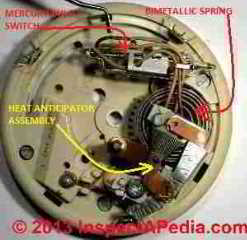 Thermostat Estrus Anticipator Operation
Thermostat Estrus Anticipator Operation
How a heat anticipator works
- POST a QUESTION or Annotate about thermostat heat anticipator circuits & controls.
InspectAPedia tolerates no conflicts of interest. We have no relationship with advertisers, products, or services discussed at this website.
Thermostat heat anticipator function & adjustment: how a thermostat heat anticipator works.
Nosotros answer: How Does the Thermostat Heat Anticipator Actually Work.
We explain how adjusting the rut anticipator pointer changes the rut output of the anticipator that in turn changes the behavior of the room thermostat to plow the burner off sooner or later with respect to the actual room temperature.
Our folio acme photo illustrates key parts of a traditional room thermostat including the temperature sensing device, thermostat switch, and the heat anticipator assembly.
We also provide an ARTICLE Index for this topic, or you can endeavour the page top or bottom SEARCH BOX as a quick way to find information yous need.
What is a Thermostat Oestrus Anticipator & How Does it Work?
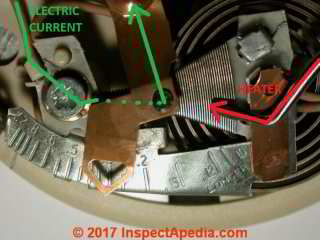 What'southward a Rut Anticipator?
What'southward a Rut Anticipator?
Many room thermostats utilise a apartment bi-metallic spring shaped into a coil that responds to changes in room temperature by moving a mercury switch (older units) that turns the buildings heating system on and off.
A heat anticipator, found inside some room thermostats, and usually about the bimetallic bound is itself a tiny electrical heater - a wire that gets warm.
Depending on its setting, the estrus anticipator warms up the bi-metal spring enough to turn the bodily heating system OFF a bit early - earlier the room has actually reached the ready-temperature on the wall thermostat.
Hence it'southward proper noun "heat anticipator" - you might say it's "anticipating" the heat rise that will keep occur in the room later the heating organisation has actually turned off.
Because many people find this concept a bit confusing, the rest of this commodity explains in more detail how the oestrus anticipator works and gives a fleck of its history.
For readers who demand to know simply how to set the rut anticipator on their thermostat, you can skip the details beneath and go directly
to HEAT ANTICIPATOR ADJUSTMENT.
A heat anticipator is used to avoid room temperature overshoot
Heating technicians call this room over-heating problem room temperature overshoot.
Stopping the telephone call for heat a little early on allows for the delivery of residual heat that is already in the banality or furnace merely that has not yet reached the living space.
[Click to overstate any prototype]
In my photo higher up the green arrow and dots show the path of electricity through the heat anticipator.
How a Heat Anticipator Produces Its Own Oestrus
Electric current flows through a tan wire to the heat anticipator's mounting screw at the left side of the photo, from there through the flat-coiled nichrome wire, up through the black contact button on the movable adjuster, through the adjuster'south copper arm, and dorsum into the thermostat.
The light-green dots show the electrical current's path through the modest left end of the heater that is more often than not hidden by copper pointer.
The ruby-red arrow, which I regret as it clutters the photos, is a pointer to the wider portion of the body of the nichrome wire heating chemical element. Find that the little nichrome wire heater is located conveniently just above the coiled bi-metallic bound that turns the thermostat'southward control wire on and off to turn the heating system on and off.
A Nano-Sized History of the Thermostat Heat Anticipator
The starting time oestrus anticipator was produced in 1924 (Walker 2008 cited at REFERENCES) in a design that, like the oestrus anticipator described in Honeywell'south T87, used the heat output of an electric current passing through a tiny heating device (a coil of nichrome wire) to warm the coiled bimetallic jump that in plough was used to plough off the thermostat ahead of the time when the room would accomplish the set temperature called for on the thermostat command.
This was an improvement to a much-older device, the electrical room thermostat patented in 1883 the U.S. by Warren Johnson (Johnson Controls).
Only ii years later in 1885 Albert Butz patented a furnace oestrus output regulator that used a moving flap to adjust air entry into a heating furnace.
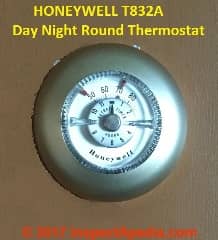
Butz's company, The Electric Oestrus Regulator Company ultimately became the Honeywell Corporation whose 1960 first round wall thermostat is shown above. This classic 1960 Honeywell T8332A round day-night thermostat is illustrated and discussed further
at Estrus ANTICIPATOR FAQs.
More details follow below.
A heat anticipator is actually a tiny electric heater within of the room thermostat
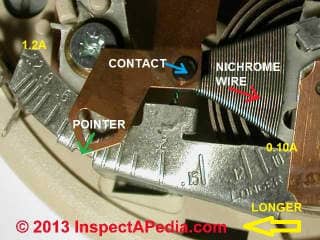 The heat anticipator, non found on all thermostats, is a tiny little electric heater that will, depending on its setting, warm upwards the inside of the thermostat, thus warming the thermostat'south room temperature sensor, thus fooling the thermostat into thinking the room is a little warmer than it actually is.
The heat anticipator, non found on all thermostats, is a tiny little electric heater that will, depending on its setting, warm upwards the inside of the thermostat, thus warming the thermostat'south room temperature sensor, thus fooling the thermostat into thinking the room is a little warmer than it actually is.
That little rut anticipating joke played on the thermostat's room temperature sensor causes information technology to "open" its contacts (cease calling for oestrus) a footling before the room temperature actually reaches the thermostat's "set" temperature.
The heat anticipator is anticipating the additional oestrus that is going to arrive and regulating the thermostat accordingly.
Thus we avoid overshooting: we avoid making the room warmer than the thermostat's set temperature.
You won't discover a heat anticipator in all thermostats. In fact most newer room thermostats employ a thermistor to sense room temperature and they do not usually include a heat anticipator device.
In our photograph above yous tin can see the critical components of a thermostat estrus anticipator such as in the Honeywell T87.
Details of how a heat anticipator works inside of a wall thermostat
The components of the estrus anticipator are shown in the photo and are explained in more item beneath. They include:
- A scale showing Amperes or current ranging from 1.2 at the left to 0.10 at the correct end of the scale.
Watch out: The location of the word "LONGER" at the right end of the Amps scale on some but not all Honeywell thermostats may be confusing
The scale includes the give-and-take LONGER imprinted at its right stop where nosotros see the lowest amps numbers.
Honeywell, a company I adore, ought nonetheless to apologize to everyone for the countless hours of defoliation acquired by this unfortunate detail.
If yous click to enlarge the photo you'll run into an arrow below the word LONGER that points to the left, to the larger Amps numbers at the other end of the calibration.
What is meant by the word "LONGER" is that for a given system, moving the lever to the left as indicated by the pointer, will result in longer cycles (lower Cycles Per Hour - CPH).
This is due to less anticipation heat beingness generated when moving the lever to the left. If the organization current is measured when setting up a system, setting the lever to that current will effect in close to 6 CPH when at l% system load. For loads less than fifty% or greater than 50% the cycling rate will be slower.
- A contumely pointer indicating the heat anticipator setting along the Amps scale.
- A resistance heating wire, probably nichrome wire, wound effectually a triangular base.
- An electrical contact that slides to different positions on the resistance wire coil.
The Nichrome Wire in the Heat Anticipator is a Tiny Electric Heater
The heat anticipator in an electromechanical thermostat includes a tiny heating coil of nichrome wire which gets warm as electricity (current) flows through the wire.
Moving the pointer along the Amps scale moves the position of the contact that in plow changes the length of nichrome wire that volition be used, making the in-use wire shorter or longer.
Pregnant of the Numbers on the Heat Anticipator Scale
The heat anticipator numbers along its scale, typically from 0.10A to 1.2A are measurements of current or Amps that volition flow through the oestrus anticipator's little heater at different settings.
At Electrical RESISTANCE vs Estrus GENERATED we explain that when the electrical resistance of a excursion is higher less current flows and less oestrus is generated.
When nosotros move the heat anticipator adjusting arm we are moving an electrical contact (blue arrow) forth the flat-wound resistor wire, effectively increasing (to the college current numbers on the left) or decreasing (to the lower electric current numbers on the right) the amps or current menstruation through this tiny heating device by lengthening or shortening the full length of wire included in the heater circuit.
Increasing or decreasing the wire length included in the excursion changes how hot the wire gets as current flows through information technology.
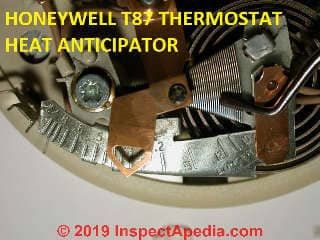
Above: the heat anticipator arrow is set to about 0.45 Amps.
Longest Rut-on Bike
For the heat anticipator above, when we move the arm and contact fully to the left to the 1.2A (longest-on position) we will see the least current catamenia, least in-thermostat-heating, then we turn the actual heating system off afterward.
Thus the highest (i.2A) position gives the longest heat-on wheel. (Jaffe 1997)
Some thermostats like the SlantFin thermostat shown below (actually made by Honeywell for SlantFin) range between 0.18A and 0.8A - the 0.8A setting gives the longest heat-on bike for this thermostat.
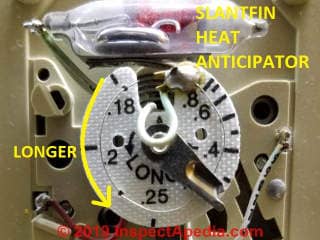
Really? Well non in all thermostat designs: there may be some thermostat rut anticipator designs that utilise a longer or shorter nichrome wire to provide more or less heat respectively past keeping the electric current flow (amps) uniform - in such a pattern the longer heater wire would put out more heat and would give a shorter heating arrangement on-bike.
Shortest Oestrus-On Cycle
If nosotros motility the arm and contact fully to the right to the 0.1A position we will see the highest electric current flow through the wire, then the wire gets hotter, so it produces the about in-thermostat-heating, then the thermostat inside warms upward faster than the room air, so the thermostat will turn off the actual heating system off sooner.
Thus the 0.1A position gives the shortest heat-on bicycle in thermostat heat anticipators of this pattern.
Watch out: in general Honeywell warns to never set the T87F serial estrus anticipator below 0.3A. Specifications and settings for other oestrus anticipator thermostat brands and models will vary.
How & Why Adjusting the Heat Anticipator Changes Its Estrus Output - Variable Resistor
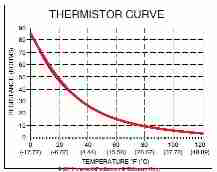 That tiny resistance wire or on older thermostats, a wire wound into a flat scroll, is a tiny electrical resistance heater that puts some heat into the interior of the thermostat, fooling information technology into thinking the room is just a little warmer than it is.
That tiny resistance wire or on older thermostats, a wire wound into a flat scroll, is a tiny electrical resistance heater that puts some heat into the interior of the thermostat, fooling information technology into thinking the room is just a little warmer than it is.
The heating thermostat manufacturer's instructions & oestrus anticipator operation caption can be a bit confusing, but significantly, as we detail
at HEAT ANTICIPATOR ADJUSTMENT
The shortest burner-on fourth dimension volition be when the rut anticipator puts out the nigh heat. This warms up the thermostat'south room temperature sensor and therefore tells the thermostat the room is upwards to set up temperature earliest.
The longest burner-on time will be when the estrus anticipator puts out the to the lowest degree heat, thus does not turn off heat early, thus lets the burner go on running longer.
The graph at to a higher place left, adjusted from 1 provided past Carrier, illustrates how a different device, a thermistor, translates temperature changes into a modify in electric resistance that in plow tin be used past a room thermostat to control building heating equipment. That'southward how newer thermostats work.
Details of those devices used in many modernistic heating and cooling thermostats are found
at THERMISTORS
Changing the Heat Anticipator'due south Arrow Changes the Wire Length, Current Amps, Heat Output
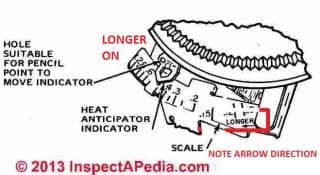 More heat output from our teensy electrical resistance heater inside the wall thermostat ways more room heat anticipation (more pre-heating of the room thermostat's sensor) and thus a shorter estrus-on cycle.
More heat output from our teensy electrical resistance heater inside the wall thermostat ways more room heat anticipation (more pre-heating of the room thermostat's sensor) and thus a shorter estrus-on cycle.
Hither nosotros explain heat anticipators a 2d fourth dimension to offer another way to empathise what's happening in a thermostat that uses a heat anticipator circuit.
Moving the heat anticipator pointer (the open triangle at the top of the copper arm) changes the effective wire length and thus the electrical resistance and thus the heat output of the heat anticipator inside the thermostat.
When we motion the adjuster nosotros are substantially using more (longer) or less (shorter) lengths of wire, thus causing more or less resistance through the device.
Primal Concepts: Relationship of Wire Length, Resistance (Ohms), Electric current catamenia (Amps), Rut Generated, Heat Anticipator Warming, Heating Organisation On-Wheel
If we assume, as is the case for a typical heating system thermostat, that the thermostat voltage level remains stock-still (typically 24VAC) and then moving the oestrus anticipator position changes the length of the nichrome wire in the active circuit.
Longer Wire = More electrical resistance = less current catamenia = less heat generated past the heat anticipator = less pre-warming of the thermostat = longer rut on bicycle.
Shorter Wire = Less electrical resistance = more current flow = more than heat generated by the heat anticipator = more than pre-warming of the thermostat's sensor = shorter burner on fourth dimension
Beneath: the heat anticipator arrow has been moved down towards the correct end of the scale, and is set to about 0.15 Amps.
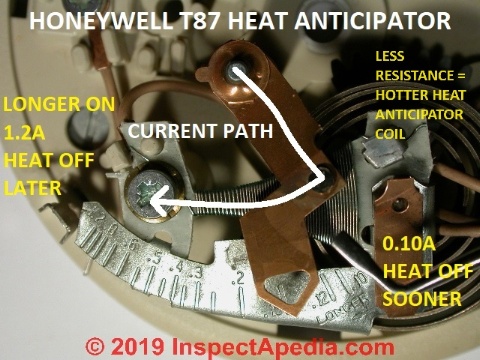
- LONGER Heat-ON Cycles: if the heating system shuts off earlier the thermostat set temperature is reached, motility the heat anticipator up to a higher number past 0.1A - this will reduce the heat anticipator output and will go on the heating organization on longer.
- SHORTER Heat-ON Cycles: If the heating system stays on too long, move the heat anticipator down to a lower number past 0.1A - this volition plow the heating system off sooner by telling the heat anticipator to anticipate or pre-warm the thermostat sensor.
Shorter Wire = Less electrical resistance = more than current flows, more than heat is generated past the oestrus anticipator = more pre-warming of the thermostat's sensor = shorter burner on fourth dimension.
Sentinel out: before changing the heat anticipator setting you might want to read both the manufacturer's actual recommended settings and our explanation near matching the heat anticipator to the actual installed-thermostat circuit's electric current depict in the rest of this commodity.
Really? Many of us accept constitute the heat anticipator in thermostats disruptive because we think intuitively but incorrectly that more than resistance means more heat is generated. No.
That'south incorrect.
More resistance (higher Amps numbers) = less current menstruation = less rut is generated = the oestrus anticipator heats up less = the thermostat turns off the heat later on (or it runs "longer").
A oestrus anticipator will not piece of work accurately unless the following atmospheric condition are met:
- The heating or air conditioning system itself has been adapted to match the electrical current of the valve or relay which the thermostat is controlling. This is a technical trouble for your heating or air conditioning service technician, non something a homeowner tin address.
- The thermostat is installed at a location where voltage and electric current (amps) autumn on or within the limits of the adjustable oestrus anticipator
- The thermostat is non installed on a power pile system (don't ask).
- The rut anticipator on the thermostat should be set to match the requirement & electrical characteristics of the particular heating or air conditioning control excursion that it is switching on and off.
Useful References for Thermostat Rut Anticipators
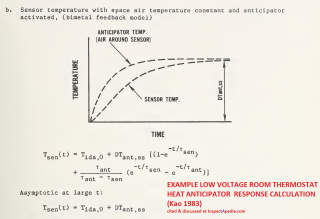
- Honeywell CT87A,B,J Circular® Thermostat Depression Voltage (fifteen to xxx VAC) Thermostat and Mounting Hardware Installation Instructions (2002) [PDF]
- Honeywell T87F Thermostat Product Data SHEET & Circuit DIAGRAMS [PDF] (2002)
- Honeywell CT87A,B,J Round® Thermostat Low Voltage (xv to 30 VAC) Thermostat and Mounting Hardware Installation Instructions [PDF], Honeywell International Inc. Honeywell Limited—Honeywell Limitée 1985 Douglas Bulldoze North 35 Dynamic Drive Gilded Valley, MN 55422 Scarborough, Ontario M1V 4Z9, threescore-0830—4 G.H. Rev. viii-02, retrieved 12/1/2013 Website: www.honeywell.com
- Jaffe, James South, THERMOSTAT HEATERS [PDF], Fueloil & Oil Heat with Air Conditioning, February 1997
- Kao, James Y., George Sushinsky, David A. Didon, A.J. Matascusa, & Joseph Chi, Low VOLTAGE ROOM THERMOSTAT PERFORMANCE [PDF] (1983) U.S. Department of Commerce & U.South. National Bureau of Standards, retrieved 2022/02/07 original source: nvlpubs.nist.gov/nistpubs/Legacy/BSS/nbsbuildingscience150.pdf
- T.D. Instruments Corporation, The MINI AMMETER used for adjusting thermostats to work precisely was produced by and may notwithstanding exist available from T.D. Instruments Corporation, 180 Charlotte St., Rochester, NY 14067 - 716-232-4208. Nosotros used model T.D. two, which operates between 0 and ane.two Amps A.C. If this instrument is not available look for an ammeter capable of operating with precision in the same very low-terminate range of current draw from 0 - 2 Amps.
- White Rodgers Thermostats and HVAC controls, Homeowner data: http://world wide web.emersonclimate.com/en-US/brands/white_rodgers/Pages/wr-homeowner-info.aspx
Contractor information: http://www.emersonclimate.com/en-US/brands/white_rodgers/wr_contractor_info/Pages/white-rodgers-contractor-info.aspxWhite Rodgers Production Catalog (don't misspell the company's name as White Rogers Thermostats) - http://www.emersonclimate.com/Documents/thermostats.pdf - Thermostat Catalog
- Domestic Fundamental Heating Wiring Systems and Controls, [book at amazon] 2d Ed., Raymond Ward, Newnes, ISBN-ten: 0750664363, ISBN-thirteen: 978-0750664363, Quoting from Amazon.com:
- "Automated Oil Burner Controls - Thermostats", Domestic and Commercial Oil Burners, [volume at Amazon] 3rd Ed., Charles H. Burkhardt, McGraw Hill, 1969 (and subsequently editions), ASIN B0000EG4Y8
- More reference sources are found at the end of this page at REFERENCES
Why Lower Electric Resistance Means More Heat is Generated and Why Higher Electrical Resistance Means Less Oestrus is Generated in a Heat Anticipator Circuit
Details near the relationship between electrical resistance and heat are at ELECTRICAL RESISTANCE vs HEAT GENERATED.
What is the Difference Betwixt the Heat Anticipator and an Aquastat Heating Control Differential?
The differential is the temperature (or pressure) change or "differential" between the Depression and HIGH settings of a heating system control.
Encounter AQUASTAT CONTROL FUNCTIONS for an instance of control differential settings on heating equipment.
Reader Comments & Q&A
I have edited as you suggested
Please clarify what you mean by "Again not for posting" - do you desire me to review and then delete your comments?
Again non for posting:
The section titled: "Details of how a heat anticipator works inside of a wall thermostat", includes an misleading/erroneous a line that says:
"This ways that the larger electric current or Amps numbers will result in a longer heating system "on" wheel. I think some dopey engineer put the discussion "LONGER" at the correct end because that's where there was plenty of room to show information technology."
It could be replaced with something similar this:
What is meant past the word "LONGER" is that for a given arrangement, moving the lever to the left equally indicated past the arrow, will result in longer cycles (lower Cycles Per 60 minutes - CPH). This is due to less anticipation oestrus beingness generated when moving the lever to the left.
If the system current is measured when setting upward a organization, setting the lever to that current will event in shut to 6 CPH when at 50% system load. For loads less than fifty% or greater than fifty% the cycling charge per unit will be slower.
Anon
I am reluctant to label a Honeywell engineer as "dopey" - and need to edit that in whatsoever instance.
But if yous take time, free energy, and generosity sufficient to signal out specific errors in whatever InspectApedia.com article I will edit and correct the text and will be glad to cite such contributors who want to be identified.
After seeing specific criticism I volition be glad to re-visit and if appropriate edit or re-write as much as needed for clarity.
Being able to cite authoritative sources and to get past "culling facts" (in other words, nonsense) is also most helpful.
I agree that discussion on this topic has confused so many people that word has been almost endless.
Lesser LINE on Room Thermostat HEAT ANTICIPATORS
For most readers the of import thing to understand is that IF your thermostat has a oestrus anticipator, y'all tin can really leave it alone, only your thermostat might work slightly better, avoiding heating "overshoot" on a call for rut, past setting the anticipator to turn off oestrus slightly early.
For readers who want to know merely slightly more about what's going on, the heat anticipator is a small electric heater inside of some room thermostats. By providing a tiny bit of actress heat the "anticipator" fools the thermostat into thinking that the room has reached the set temperature on the thermostat a little before the room has actually done-and so, causing the thermostat to shut off the boiler slightly "early".
The reason for that feature is that some heating systems such as large bandage fe radiators, have so much thermal mass that they go on to radiate a lot of estrus fifty-fifty after the thermostat has been satisfied and has turned off the boiler. The result tin be temperature "overshoot" in which the room gets a chip warmer than occupants want.
Just a few questions, but not post: Will the main article include a correction nearly the dopey Honeywell engineer? How do you handle these updates then that they jive with older comments? Is it fourth dimension to rewrite the article to be accurate and include more item?
Thank you very much, Anon for the helpful annotate and for that NIST government publication - it'due south a great find and not ane I had in our library; I'll add it for ease of location by other readers;
Kao, James Y., George Sushinsky, David A. Didon, A.J. Matascusa, & Joseph Chi, Low VOLTAGE ROOM THERMOSTAT PERFORMANCE [PDF] (1983) U.S. Department of Commerce & U.S. National Bureau of Standards, retrieved 2022/02/07 original source: https://nvlpubs.nist.gov/nistpubs/Legacy/BSS/nbsbuildingscience150.pdf
I knew the engineer who put longer on that part. It is in the correct management. As some have pointed out above the anticipation resistance in small compared to the full resistance in the system. Thus the arrangement has well-nigh constant current when in the on wheel independent on anticipator setting. Why does this make longer indicate to the left?
Assume the anticipator is set up to the farthest right of the scale. This will provide the maximum anticipator oestrus and shortest cycles for the system. If moved to the left, the resistance will be less as the wire is shorter. The electric current stays the same therefore the anticipator estrus is reduced. Reduced anticipator oestrus volition cause the system to cycle slower therefore longer cycles.
There is a subtle thing that happens when the anticipator contact passes the little twisted tap. Part of the anticipator is in parallel with the bimetal of the thermostat. Part of the electric current goes through the bimetal when the anticipator is to the right of the tap.
The current in the bimetal produces direct heating of the bimetal. Moving left of the tap less current flows through the bimetal and more current flows through the anticipator but at reduced resistance. This again lowers the anticipator estrus.
Many mechanical thermostats are designed to cycle effectually 6 cycles per hr at a fifty% load. The markings are adamant by testing at diverse current levels using a NEMA test chamber as described in:
https://nvlpubs.nist.gov/nistpubs/Legacy/BSS/nbsbuildingscience150.pdf.
This article besides delves in to the math behind anticipation.
Thanks, William;
Prompted by your comment, I recall coming beyond that and inserting information technology into the text.
Keep in mind that voltage drop is non the aforementioned number as electric resistance - though they're related.
Thank you! I asked considering a lot in this article didn't make sense to me.
I found my reply in the
HEAT ANTICIPATOR ADJUSTMENT - T87 article. [Discusses Ohm's Police force - Ed.]
"The anticipator resistance is much lower than the resistance of the gas valve gyre [or the circulator relay coil]. That means that no matter where the anticipator is adjusted, it does non appreciably affect the current in the circuit. In other words, the current through the anticipator is constant for your furnace [or hot water banality or steam banality], no thing where the anticipator is adjusted."
So we want the voltage drop across the thermostat to be quite small perhaps 2-volts at almost.
RE-posting:
William O. said:
What is a typical resistance across the entire length of an anticipator heater in a thermostat?
This Q&A were posted originally at ELECTRICAL RESISTANCE vs HEAT GENERATED
Moderator reply:
William
Thank you for a helpful question on the resistance of HVAC thermostat heat anticipators.
Please see details at HEAT ANTICIPATOR Functioning
where we notation that the range of adjustment of a typical Honeywell heat anticipator was betwixt 1.2A and 0.10A.
The electric current powering most heating system thermostats is 24VAC.
Resistance in Ohms R (Ω) = Volts ÷ Amps or V/I or about 20 ohms.
Give thanks yous, William
I will again review and edit appropriately
Next two lines from: https://inspectapedia.com/heat/Heat-Anticipator-Operation.php (slightly abbreviated)
Longer Wire = More resistance = less current = less heat generated by anticipator = less pre-warming of thermostat = longer rut on cycle.
Shorter Wire = Less resistance = more electric current = more estrus generated past anticipator = more pre-warming of thermostat's sensor = shorter burner on fourth dimension
Hmmm? - for longer on fourth dimension we move the pointer (left) to MORE current (shorter wire) -- for shorter on fourth dimension move pointer (right) for LESS current (longer wire)
So: With more wire exposed to less current we must be getting more heat for shorter on fourth dimension. thus longer wire = higher heat fifty-fifty though less current
This old heating article volition be of involvement
Jaffe, James Due south, THERMOSTAT HEATERS [PDF], Fueloil & Oil Rut with Air Conditioning, February 1997
at inspectapedia.com/estrus/Thermostat-heaters-Jaffe.pdf
The schematic below is from a current T87F Family unit production data sheet from Honeywell, cited in these manufactures
IMAGE LOST by older version of Clark Van Oyen'south useful Comments code - now fixed. Please re-post the paradigm if you tin. Sorry. Modern.
no, more resistance is more than heat from the anticipator, considering the electric current is basically abiding (chastened past the resistance of the relays and solenoids at the other end of the wire.
Betimes
Understanding heat anticipators and anticipator adjustment directions has long been a topic of confusion despite the very modest role this feature played in heating systems and thermostat use.
So I HAVEN'T been crazy about the arrow existence wrong, all these years! What a relief.
Dave: possibly if you subjected the thermostat to very high temperature. Y'all'll know if by turning up the thermostat to in a higher place the current room temperature that fails to plow on your heating organization - an easier test than the hair dryer approach.
I used a pilus dryer to heat my Honeywell T-87 type room thermostat to see if it would shut downward my Crown boiler. That worked every bit a exam but at present I wonder if that could dammage the anticipator.
Certain, Jenn,
Please utilise the website search box only above to detect our article
Estrus WON'T TURN OFF
And you lot'll discover a sequence of Diagnostic and repair suggestions for just this trouble. Please take a expect and permit me know if you take further questions and I'll be glad to work directly with yous on this
Daniel
I turned my thermostat off but heat is notwithstanding felt on my heaters I live in a building any suggestions
...
Go on reading at Rut ANTICIPATOR Adjustment or select a topic from the closely-related articles beneath, or meet the complete ARTICLE INDEX.
Or encounter these
Recommended Articles
- AMPS MEASUREMENT AUTOMOTIVE DC
- AMPS MEASUREMENT METHODS
- BOILER CONTROLS & SWITCHES
- DEFINITION OF AMPS, ELECTRICAL CURRENT
- DEFINITION OF OHMS, ELECTRICAL RESISTANCE
- Electrical RESISTANCE vs HEAT GENERATED
- FURNACE CONTROLS & SWITCHES
- HEAT ANTICIPATOR Adjustment
- HEAT ANTICIPATOR ADJUSTMENT - T87 - and the role of Ohm's Law (resistance)
- Oestrus ANTICIPATOR EFFECTS on ROOM TEMPERATURE
- Estrus ANTICIPATOR OPERATION
- HEAT ANTICIPATOR FUNCTION
- Heat ANTICIPATOR REQUIREMENTS
- HEAT ANTICIPATOR SET & TEST by AMMETER
- HEAT ANTICIPATOR THERMOSTAT SOURCES
- Rut WON'T TURN OFF
- STEAM HEATING SYSTEMS
- TEMPERATURE RESPONSE of ROOM THERMOSTATS
- THERMOSTAT WIRE CONNECTIONS
- VOLTS / AMPS MEASUREMENT EQUIP
Suggested citation for this web folio
Heat ANTICIPATOR OPERATION at InspectApedia.com - online encyclopedia of building & environmental inspection, testing, diagnosis, repair, & problem prevention advice.
Or see this
INDEX to RELATED Articles: ARTICLE INDEX to HVAC THERMOSTATS
Or use the SEARCH BOX plant below to Ask a Question or Search InspectApedia
...
Enquire a Question or Search InspectApedia
Endeavor the search box merely below, or if you prefer, post a question or annotate in the Comments box beneath and nosotros will respond promptly.
Search the InspectApedia website
Note: appearance of your Comment below may be delayed: if your comment contains an image, web link, or text that looks to the software as if information technology might be a web link, your posting volition appear after it has been approved past a moderator. Apologies for the filibuster. Our Comment Box is provided by Countable Web Productions countable.ca
Technical Reviewers & References
Click to Show or Hide Citations & References
Source: https://inspectapedia.com/heat/Heat-Anticipator-Operation.php

0 Response to "How To Set The Anticipator On A Thermostat"
Post a Comment